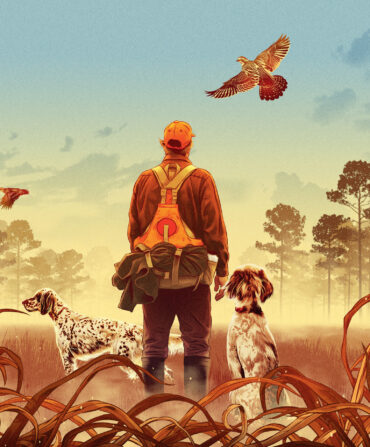Good Dogs
Leader of the Pack
Mike Stewart has turned the world of gun dog training upside down

Photo: Andy Anderson
It’s a sunny autumn morning, and Mike Stewart is walking across the precisely trimmed grass at his Wildrose Kennels, a dozen miles east of Oxford, Mississippi, where a year-old black Lab, Aggie, waits for him to return.
Stewart is tall, lean, and sometimes laconic or direct in his manner. He is also widely acknowledged as one of the best dog breeders and trainers in the world. And—aside from possessing a patience with canines few others will ever develop—he has created a system for training Labrador retrievers few can imitate. Fifteen minutes earlier, he and some of his staff were working with a handful of year-old Labs in training. They had been using a live pigeon to test the dogs’ ability to remain steady in the face of feather-filled distraction. The bird fluttered past their snouts, over and over. None of the dogs budged. They saw the pigeon, yet they didn’t move.
Then Stewart summoned all of the dogs but Aggie (whom he neglected to call) and walked them back to their pens. He was gone for some time. During this period, Aggie watched him walk away, but she didn’t get agitated—or even move. Her eyebrows didn’t begin that “I’m concerned” up-and-down semaphore dogs use. She simply, patiently waited.
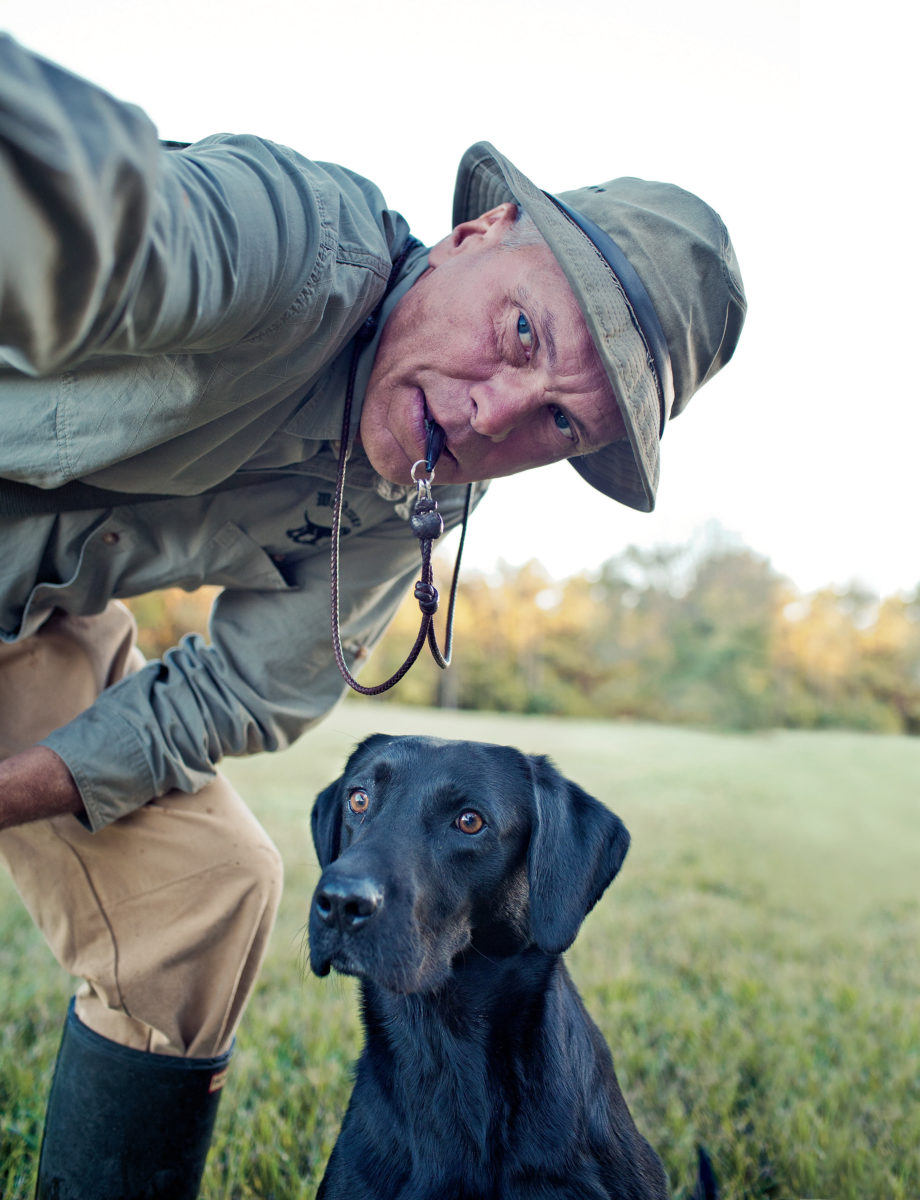
Photo: Andy Anderson
Mike Stewart and friend do some whistle training.
As Stewart returns with two “finished” Wildrose Labs—Deke and Booch—who are slated to do some review work at a nearby pond in heavy downed timber, he sees his oversight, and is embarrassed about leaving Aggie still sitting on the lawn.
“I just forgot her,” he says, walking over to the dog. Then he invites Aggie to stand, and scratches her behind the ears. “She’s a good dog,” he says. “And she’s going to become a great dog.”
The Top Dog
This is the root source of Wildrose Kennels. This is “the Wildrose Way,” a training technique Mike Stewart not only pioneered in the 1970s but also has been wise enough to trademark. Using a pure English Lab line of heredity and a “Cyclical” training model that Stewart developed and loves to talk about, Wildrose—without employing typical dog-school tools like shock collars and negative reinforcement—produces among the best-behaved “gentlemen’s gun dogs” in the world.
Wildrose has also, in recent years, branched out from hunting Labs. It now also trains “adventure dogs”: calm, knowledgeable dogs that are game for such various undertakings as snowshoeing, camping, boating, and polite companionship when you take one to your office or a restaurant.
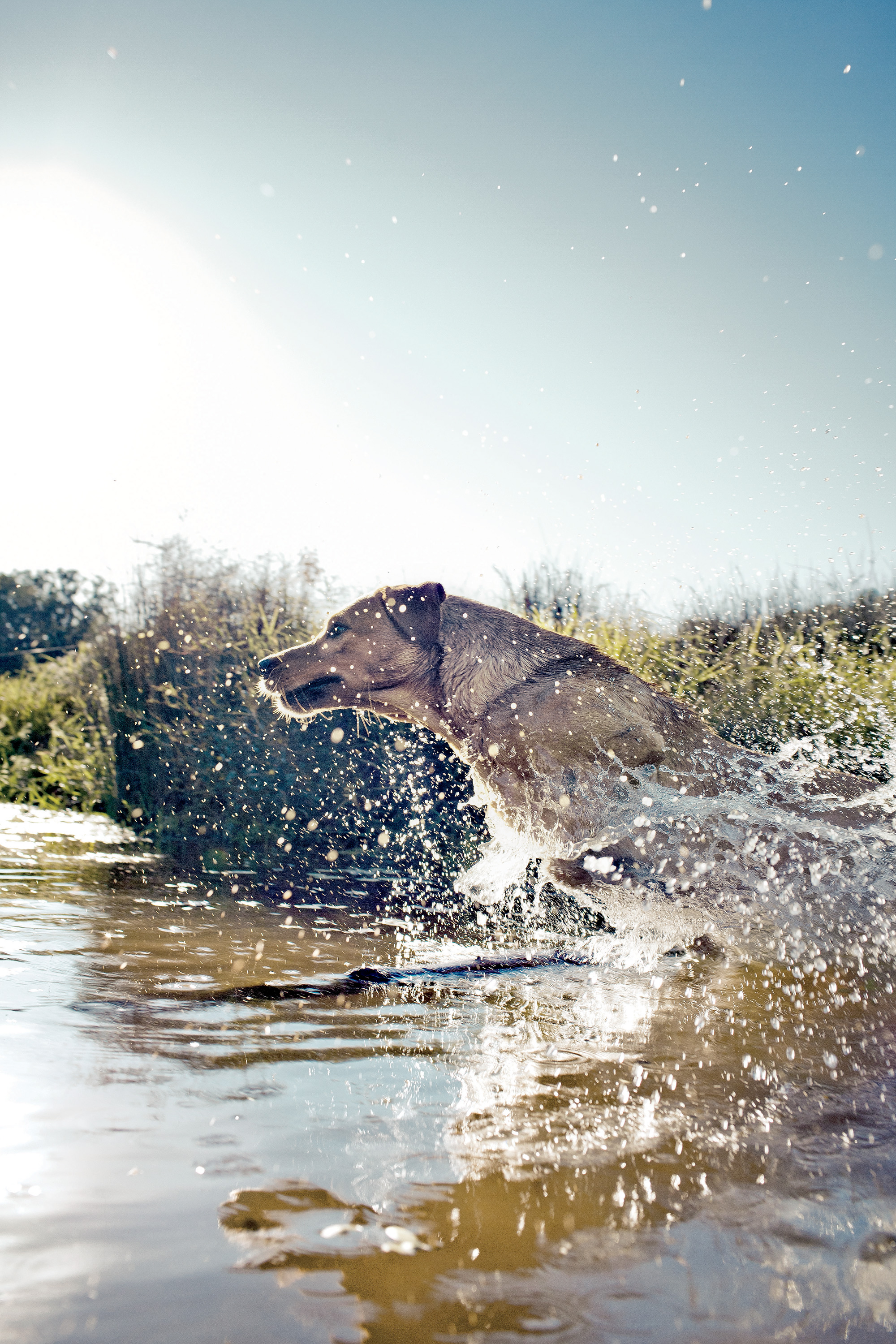
In the last two years, the kennels have also started training Wild-rose Labs as “diabetic dogs,” since in addition to their affability, the dogs’ good noses allow them to pick up on the change in a diabetic human’s breath as the person descends into potentially dangerous low blood sugar, alerting the master of the impending problem.
“Fully finished” Wildrose dogs aren’t cheap; they run from $10,000 to $15,000, depending on their skill sets. And so you have to ask yourself: Is any dog worth that?
Still, as testimony to the dogs and their abilities, Stewart’s list of repeat customers is long and impressive. It includes Richard Adkerson, CEO of the mining giant Freeport-McMoran; Steve Reynolds, CEO of Baptist Hospital Systems; and John Newman, president of Ducks Unlimited.
Stewart and his wife, Cathy, plus a staff of about a dozen, work at Wildrose Kennels’ home base, 143 well-tended acres of field, ponds, and timber east of Oxford. They also have training facilities in Arkansas, and access to 580 acres of gorgeous Clear Creek Ranch in Colorado, where they teach adult dogs higher-altitude skills. Beyond that, they maintain several partnership facilities in the United Kingdom, where the Wildrose bloodline originated.

Photo: Andy Anderson
Stewart works on hand signals.
“I’m a retired cop,” Stewart says, as he walks me toward a line of kennels on the property. “Seven years with the Oxford, Mississippi, police department, then eighteen as chief of police at Ole Miss. But I’ve been piddling around training dogs as long as I can remember. I’ve always loved dogs—and training them. I trained my first Lab, Pepper, in 1972. Sold her in 1973. Great dog.”
As we walk across the grounds in the late afternoon, Stewart stops walking for a moment and crosses his arms over his chest, his right hand clutching his elbow. He smiles. You can tell, simply by the look on Stewart’s face: Pepper was a great dog.
Fieldwork Done Right
We walk up to several of the kennels, where the line of penned Labs—without barking—stand and watch, their coats shiny in the shade, their demeanors as tensely optimistic as beauty queens hoping to be picked.
“All our kennels are a little bit round,” Stewart says. “Because nature is rarely in a straight line. Also, they have sand floors. Which is much easier on the dogs’ elbows and other parts of their bodies than concrete floors.”
He introduces me to several dogs, including the black Lab named Deke, who is the Ducks Unlimited mascot and a Wildrose favorite, and others named Indian and Ben, but ends up in front of the one-year-old Aggie’s kennel. Stewart swings open that pen’s door, and the dog walks to the open door and then stands still inside, patiently waiting.
“My technique,” Stewart says, “is something I call Cyclical Training. The dog has to be invited out—Aggie, come—and with every command, you say the dog’s name. That way, you can have several dogs in a duck blind, say, and after taking a bird you can call one of their names and set it loose and the others will stay.”
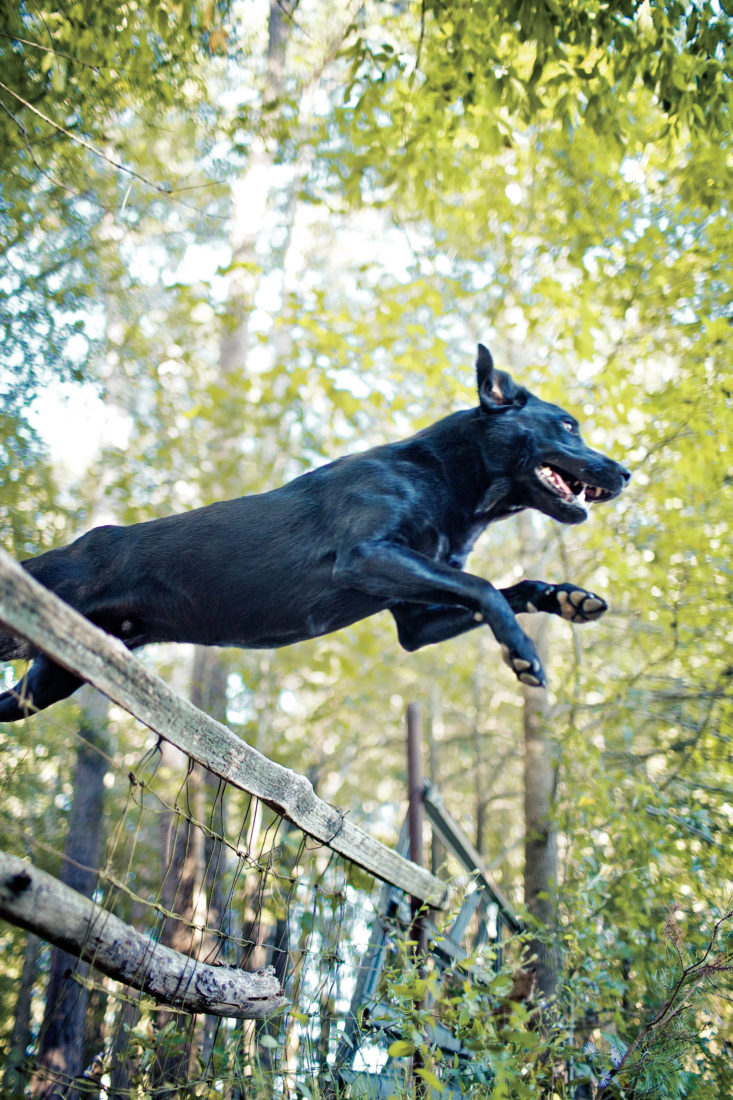
Photo: Andy Anderson
Catching air on the ground of Wildrose.
After asking the dog out of its kennel, Stewart begins what he calls “the Ramp-Up.” It starts with a slow walk with the dog at left heel for a few minutes (with several stops, directed by the handler, not the dog), then a faster walk. Then, after five or ten minutes, the dog and handler get to it. An initial part of that is a critical step Stewart calls “Denial and Delay” or “Memory Work”: a stage when the dog senses something fun is about to happen, but then this step is withheld for a short period.
We are now standing in the middle of a field, a few hundred yards from the kennels. Aggie is ready and waiting. Stewart fires a training bumper into the woods nearby. Aggie watches the bumper fly, but doesn’t move from Stewart’s side. But instead of sending Aggie to retrieve the bumper, Stewart turns from where the bumper landed in the forest, and walks in the other direction.
“Aggie…heel,” Stewart tells the dog as he begins to walk. (“It’s important to look the dog in the eyes for three seconds when you give it a command, too,” he’ll later tell me.) Aggie stays with him as they walk away from the bumper. Finally, thirty or so paces later, Stewart lifts his Acme training whistle, which hangs on a lanyard around his neck. He turns to face the woods where the bumper landed. Aggie turns, too.
He looks the Lab in her eyes. “Aggie,” Stewart says.
The dog rockets away from him toward the bumper, and Stewart places the whistle in his mouth—blowing a quick peeeep—about the time the dog is halfway there. Aggie stops in her tracks, in the tall grass, waiting. Five seconds pass.
“Aggie,” Stewart says again. The dog streaks into the timber, retrieving the bumper and bringing it directly back to Stewart, who rewards her with praise and some scratches behind the ears and under the chin.
“That’s a good dog, you are a good dog,” Stewart says.

Photo: Andy Anderson
Stewart and a pair of Labs head into the woods for an evening walk after a training session in the field.
From Started to Finished
Still, you have to ask: $10,000 to $15,000 for a “fully finished” hunting, adventure, diabetic-alert, or companion dog?
“Well, you can purchase a puppy from our bloodline for $1,500,” Stewart says one afternoon as we walk toward the kennels’ full veterinary clinic, complete with vet techs that monitor and record the health of each Wildrose dog every day. “But when you factor in the cost of this place, the time my four full-time trainers spend with each dog [each dog works with one trainer, so it doesn’t get confused], my expenses, and dog food and medical care for the dogs and other things, well, I think it’s a fair price. Hey: People will have these dogs as life and sporting companions for ten to fifteen years. They often spend far, far more than that on a car, which they might have for, what, four years? And that’s just a car.”
Plus, between the training and that Wildrose proprietary bloodline, you’re still only seeing the end result of the Wildrose Way. Working a newborn puppy into the system, for instance, begins on day three of its life, when its eyes are only first opening. There’s the “Super Scent” program, where small containers of different smells (that of a wild bird, or grass, or a “neutral” or “control” scent) are put in with the puppies and their mothers on different days, to imprint them.
After that comes the “Super Learner” aspect of Wildrose puppy training. By three and a half weeks old, the puppies are encouraged to navigate through a snaking, perhaps fifty-foot-long “training maze,” including going up and down small stairs, walking across a large mirror placed on the floor, running down the length of a child’s nylon tunnel held open with a length of helical wire, climbing over small logs, and, finally, ducking beneath a “low bridge” to make the finish. When each puppy completes the course, its joy—expressed through running and hopping and simply acting like a happy young dog—is visible.
From seven weeks to roughly six months, each puppy on a “finishing track” is taught a solid set of “foundation skills.” These include heeling, appropriate private and public behavior, and simple signals such as whistle training and, eventually, hand signals. There is also a covered, fifty-yard-long training aviary containing both ground birds (such as quail and pheasant) and flying and perching birds, such as doves and pigeons. The trick when entering and walking a dog through the birds is to give regular signals, interacting with the dog, and staying so focused on each other that the dog does not get distracted by the running and flying birds. It’s a high-performance exercise in building trust and patience—for both human and canine.
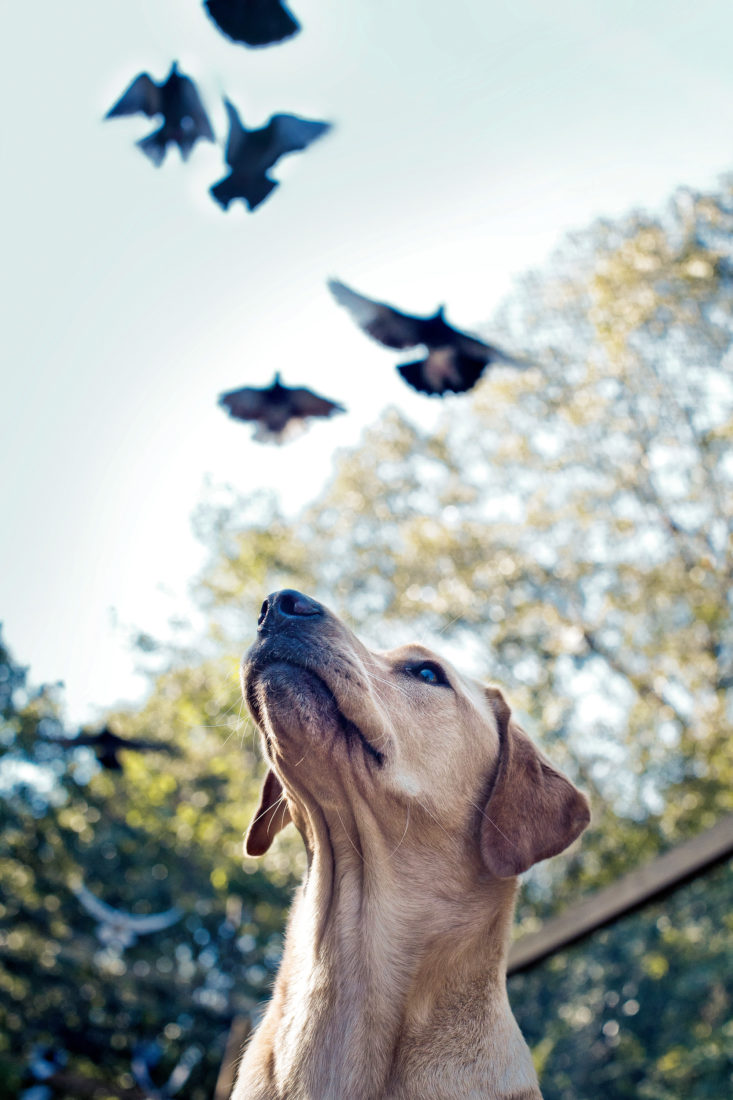
Photo: Andy Anderson
A lab spends time in the aviary pen to help with its steadiness.
“It’s memory before hand signals,” Stewart says, “and hand signals before hitting marks. And all the time, you reward them equally for both patience and for work.”
At about eight months of age, the Wildrose Way finally gets down to each dog’s actual specific hunting, adventure, or diabetes-alert awareness training. “People want different things from their dogs,” Stewart says, “and so we work on those—hard.” This may include working on as many as three different behavior sets during any day’s “cycle,” and always ends with a “counter-skill.” For instance, if you’ve been working on a dog’s nose and scent training that day, Stewart says, the day’s last exercise should require it to use its eyesight.
“And you always end a training cycle on a success,” Stewart says. “When the dog goes home after a day of work, it needs to know it did a good job.”
Gun Work
The dogs, it almost goes without saying, do a stunningly good job. Another morning finds Stewart, me, and my eighteen-year-old son, James, down in a skeet field, a 16-gauge over-and-under shotgun racked open and dangling from the crook of my left elbow. With us are two fully finished Wildrose dogs, Deke and Indian, who can’t wait to get busy. There will be clay-pigeon shooting and, in the midst of it, bumpers for the dogs to retrieve, fired across the overgrown grasses.
“By the time one of our dogs is fully finished,” Stewart says, “it should be able to factor in all sorts of distractions and stay on task. That’s the goal.”
The shooting starts. The dogs stay put; they’re sitting without leads by Stewart’s knee as shotgun blasts pulverize disks of orange flying clay against a blue morning sky. Finally, a bumper is fired, falling far downhill in the tall grass. Stewart waits a second. The dogs—one black and one yellow—begin to vibrate subtly. Stewart turns and steps away from where the bumper landed in the field. The dogs follow. Stewart turns back toward where the bumper landed, perhaps eighty yards downhill in the field.
“Teaching and reinforcing calm and patience in them is huge, it’s just huge,” Stewart says. He looks down at the two dogs near his knee.
“Deke,” Stewart says. The black lab tears into the field: a full-out sprint. It returns about forty seconds later, carrying the bumper.
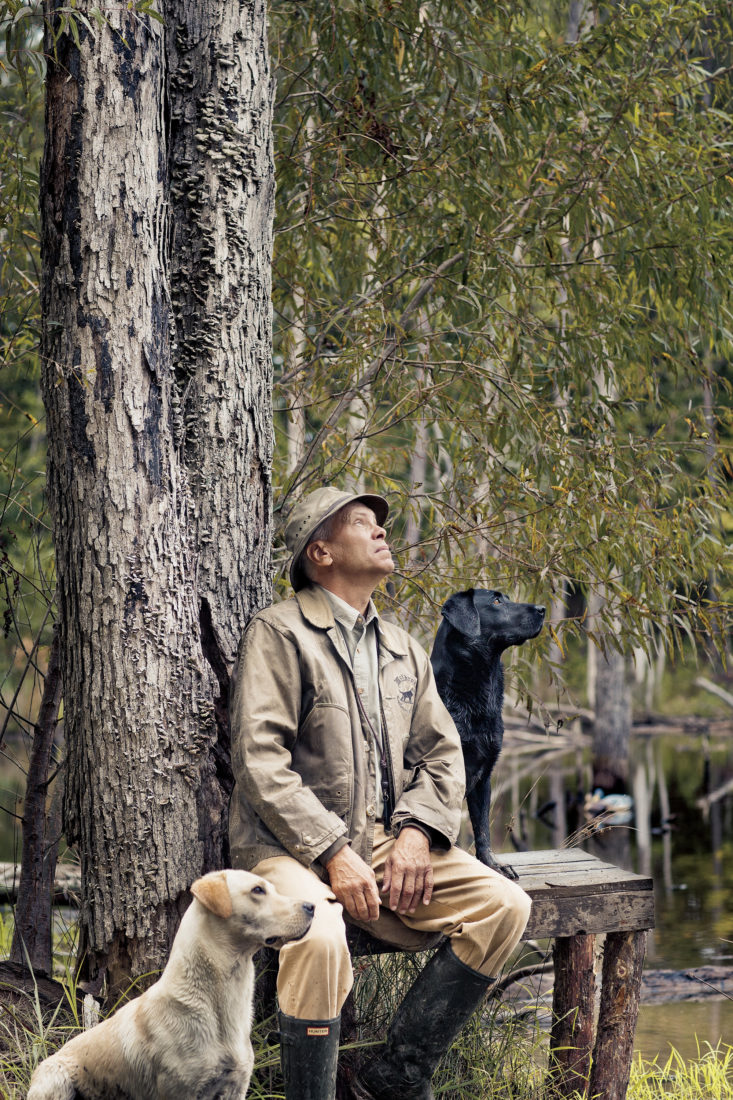
Photo: Andy Anderson
Stewart and proteges watch the sky for birds.
As Stewart removes the bumper from the dog’s mouth, he’s praising Deke and rubbing the dog’s ears and chin, telling him how good he is. Watching Stewart and the dogs working together in the morning light is a thing of beauty. It’s men and dogs, living side by side, via some agreement both species cut thousands of years ago that is still going strong.
In the filtered morning light, the dogs are ready for more shooting. More fun. And, I must add, so are the people.



